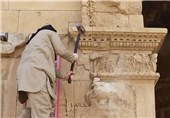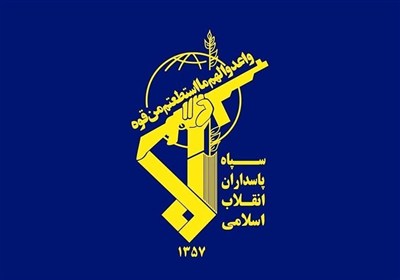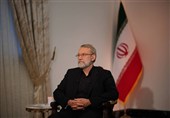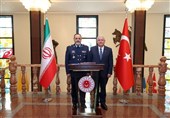ISIL Destroying Precious Heritage Sites in Syria, Iraq
TEHRAN (Tasnim) – ISIL’s demolition of the Saint Elian Monastery in the central Syrian province of Homs is the latest in a long campaign that has destroyed or extensively damaged some of the Middle East’s most spectacular archaeological and cultural sites.
Some of the world’s most precious cultural treasures, including ancient sites in the cradle of civilization, are in areas controlled by the group and at the mercy of extremists bent on wiping out all symbols of culture and history. The militants have also targeted churches, mosques and museums.
The rampage, targeting priceless cultural artifacts often spanning thousands of years, has sparked global outrage and acc0usations of war crimes. The militants are also believed to be selling ancient artifacts on the black market in order to finance their bloody campaign across the region.
In May, the extremists captured the central Syrian town of Palmyra raising fears they would demolish the 2,000-year-old Roman-era city at the edge of the town – a UNESCO world heritage site and one of the Mideast’s most iconic archaeological sites.
Here’s a look at some of the major sites destroyed by ISIL in Iraq and Syria, and others under their control, reported by the Associated Press on Saturday:
SAINT ELIAN: ISIL posted Friday photographs on social media sites showing bulldozers destroying the 1,500-year-old monastery.
PALMYRA: ISIL terrorists fully captured the central Syrian town, home to one of the Middle East’s most spectacular archaeological sites, in late May. In June, the head of the Syria’s Antiquities and Museums Department, Maamoun Abdulkarim, said ISIL militants had destroyed a lion statue dating back to the second century. The statue, discovered in 1975, had stood at the gate of the town’s museum, and had been placed inside a metal box to protect it from damage. In July, ISIL released a statement saying that six busts from Palmyra had been confiscated from a smuggler. Photographs released by the group showed ISIL militants destroying the busts with large hammers and the smuggler being whipped.
ISIL militants Tuesday publicly beheaded Khaled al-Asaad, an 81-year-old Palmyra resident and antiquities scholar whose lifelong work had earned him the nickname “Mr. Palmyra” in the archaeological community.
This week, UNESCO chief Irina Bokova told the Associated Press that satellite images of Palmyra revealed a network of holes dug in the area for “illicit excavations and then eventually trafficking and looting.”
NIMRUD: In the ninth century BC, Nimrud, also known as Kalhu, became the second capital of Assyria, an ancient kingdom that came to rule much of present-day Iraq and the Levant and became a great regional power. The city, which was destroyed in 612 BC, is located on the Tigris River just south of Iraq’s second largest city, Mosul, which was captured by ISIL in June 2014. The late 1980s discovery of treasures in Nimrud’s royal tombs was one of the 20th century’s most significant archaeological finds. The government said militants destroyed the site in March using heavy military vehicles.
HATRA: One day after the destruction of Nimrud, ISIL militants bulldozed the 2,300-year-old ruins of Hatra, a well-preserved complex of temples south of Mosul and a UNESCO World Heritage site. The move was described by UN Secretary-General Ban Ki-moon as a “war crime.”
MOSUL MUSEUM: On Feb. 26, a video emerged on militant websites showing ISIL militants with sledgehammers destroying ancient artifacts at the museum in Mosul which they referred to as idols.
They also destroyed the Nirgal Gate, one of several gates to Ninevah, the onetime capital of the Assyrian Empire.
MOSUL LIBRARIES: In January, ISIL militants ransacked the Central Library of Mosul, smashing the locks and taking around 2,000 books. Days later, militants broke into the University of Mosul’s library. They made a bonfire out of hundreds of books on science and culture, destroying them in front of students.
SHRINES: Last year, militants destroyed the centuries-old Mosque of the Prophet Younis – believed to be the burial place of the Prophet Jonah – and the Mosque of the Prophet Jirjis, two revered ancient shrines in Mosul.
They also threatened to destroy Mosul’s 850-year old Crooked Minaret, but residents surrounded the structure to protect it.
DURA EUROPOS: The 2,300-year-old city overlooking the Euphrates River is a remarkably well-preserved cultural crossroads, a city first founded by Alexander’s successors and later ruled by the Romans and various Persian empires. It boasts pagan temples, churches and one of the earliest known Jewish synagogues. Satellite imagery taken last year show the site pockmarked with holes from pillaging and illegal digs. It also showed hundreds of people conducting illegal excavations.
MAREA: An ancient city located on the site of Tell Hariri on the western bank of the Euphrates River in Deir al-Zor province. It is believed to have been inhabited since the fifth millennium BC and was discovered in the early 1930s. It has also been severely looted by ISIL.
TAL AJAJI AND TAL BRAK: Prehistoric settlement mounds in Syria’s far eastern Hassakeh province. Experts say both have been looted and destroyed, artifacts have been removed from both sites, and ancient statues – some dating back to the Assyrian period – have been smashed.






